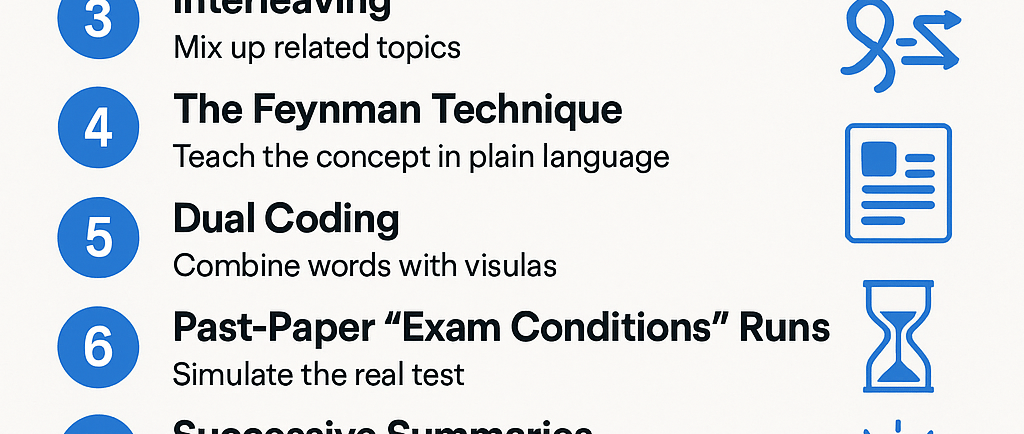Top 10 Revision Strategies Every Student Should Try


Balancing study time with life’s many distractions can be tough. The good news? A handful of proven, brain‑friendly tactics can make revision far more efficient—so you remember more in less time and walk into exams feeling confident. Here are ten strategies worth adding to your toolkit:
Spaced (Distributed) Practice
Instead of marathon cramming sessions, break study blocks into shorter bursts spread over days or weeks. The gaps give your brain time to consolidate memories, strengthening long‑term recall. A quick rule of thumb: review new material one day later, then after three days, a week, and a month.Active Recall
Close the book, hide the notes, and try to retrieve facts from memory—through flashcards, self‑quizzing, or explaining the topic out loud. The act of pulling information out is what wires it in, outperforming passive rereading every time.Interleaving
Mix up related topics instead of studying one unit exhaustively before moving on. For example, in math, switch between algebra, geometry, and statistics within a session. The brain learns to detect similarities and differences, boosting flexible problem‑solving.The Feynman Technique
Teach the concept in plain language as if to a younger sibling. Wherever you stumble, identify knowledge gaps, revisit the source, and refine your explanation. Simplicity is a litmus test for real understanding.Dual Coding
Combine words with visuals—mind maps, diagrams, timelines, or infographics. Translating prose into images (or vice versa) forces deeper processing and creates multiple “hooks” for retrieval.Past‑Paper “Exam Conditions” Runs
Simulate the real test: same time limit, no notes, minimal distractions. Afterwards, mark strictly using the official scheme. You’ll uncover weak spots, practice pacing, and desensitize exam nerves.Successive Summaries
Write a 200‑word summary of a chapter. Shrink it to 100 words, then 50, then a tweet‑length 280‑character version. Each compression distills the core ideas and reveals what truly matters.Elaboration with Concrete Examples
Ask “Why?” and “How?” about each fact, and tie abstract ideas to real‑world cases. Explaining osmosis through wilted lettuce in salty water, for instance, cements the theory far better than a definition alone.Retrieval‑Focused Flashcard Apps (with Spaced Algorithms)
Digital tools like Anki or Quizlet’s “learn” mode schedule each card just before you’re predicted to forget it. Build cards that demand thinking—fill‑in‑the‑blank, diagrams to label—rather than simple keyword prompts.Strategic Breaks & Multisensory Refreshers
Follow a 50–10 or 25–5 work‑break rhythm (Pomodoro style). During breaks, move: stretch, walk, grab water, listen to upbeat music. Light exercise boosts blood flow and neurotransmitters, priming the brain for the next round.
Putting It All Together
A solid revision plan might look like this:
Map out a spaced schedule leading up to exam week.
For each session, create active‑recall flashcards or summary sheets.
Interleave subjects: Monday morning – chemistry/biology mix; evening – history/math mix.
End sessions with a Feynman explanation to your study buddy (or a voice note).
Once a week, do a full past‑paper mock under timed conditions.
Keep breaks sacrosanct—short, physical, and phone‑free.
By layering these techniques, you’ll move beyond passive reading into deliberate, brain‑optimized learning. Start small—pick two or three methods this week—and iterate. Consistency beats intensity, and smart revision beats endless hours. Good luck!
